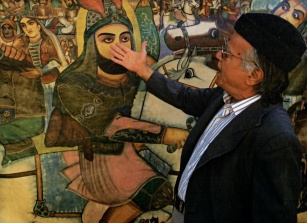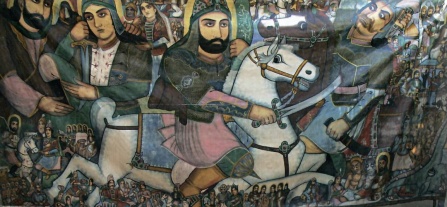Shokrollah karimi kamare
Shokrollah karimi kamare | |
|---|---|
 | |
| Born | 1938 Arak |
| Nationality | Iranian |
| Known for | Pardekhani and Maddahi |
| Patron(s) | His Mother, Ruhollah Karimi (his brother) and Haj Rahim Esfahani |
Shokrollah Karimi Kamare (born in 1938) is an Iranian Pardekhan who began his career when he was only six years old. The method of Morshed Karimi is a combination of encomiastic motions and those of the curtain-storytellers. The encomiasts recite their praises sitting on a podium and the narrator singers stand in front of the curtain and sit only for short moments. Morshed Karimi brings about a beautiful fusion of methods of encomiasts and curtain-narrators tending mostly towards movements of the hands, head and neck in standing position.
Performance Method[edit | edit source]
He transforms his body movement from subtle into a very rich gesture style, with the help of his rough sound which is a specialty of encomiasts. The audience has to wait for him to perform an innovative movement on correspondence with the content of the gathering being described. In contrast to the tradition method of curtain-storytellers which use many subtle movements, Morshed Karimi introduces a stylized special method of Pardekhani.
Reciting Method[edit | edit source]
Morshed Karimi learned curtain-storytelling and encomium from his Mother and brother when he was a child. His chanting is composed of encomium and storytelling. Enough knowledge, a strong memory, and mastery of the religious melodies gives him the capability of singing the whole scene mainly poetry. In the recitation of his gathering, he uses from the poems of Asef who is one of the religious Qaside singers (odist) and the above-mentioned quality is manifested in his recitation.
The general atmosphere in this Pardekhani is near to the Homayun Dastgah (mode) but the created melody is foreign to the Dastgah music in terms of Pishdong intervals, melodic movement, and also the melody models and accents. This atmosphere roughly continues with the same melody up to the end of the curtain-storytelling and even in the spoken words of the curtain-narrator singer, the musical sounds play a major role and the musical atmosphere is not lost. The Pardekhan does not keep a constant tempo in reciting the poems and text of the Pardekhani (curtain-storytelling) and we witness a change in tempo based on the meanings of the story and at times it quickens up or slows down. However, another change also happens during the curtain-storytelling and that is rough change of tonality to a higher pitch and then lower in the last minute of the Pardekhani. Since then the singer being influenced by the sung intervals during the whole performance and rises the tonality of his voice and gradually reaches the previous intervals.
Narration[edit | edit source]
Before the battle, the war hero Hurr falls into doubt about the army which he has joined and being on the side of truth. The spirituality dominant in the army of Imam Hussain draws him as he remembers Imam Hussain's past and joins his army with a profound faith, he moves on to martyrdom.
Source[edit | edit source]
- Ardalan, hamidreza (2008). Picture-storyteller masters of iran, the Iranian academy of the art, 2008, volume 11. ISBN: 978-964-2986-446(vol.11). 978-964-2986-002(set).


